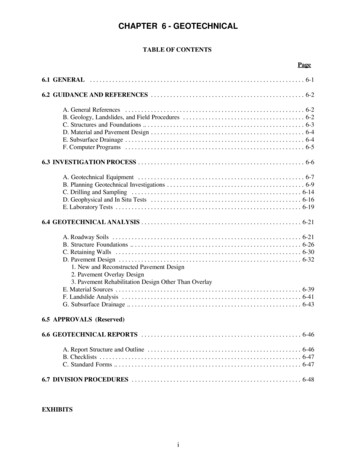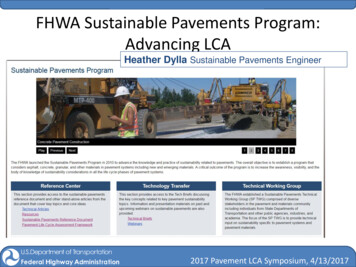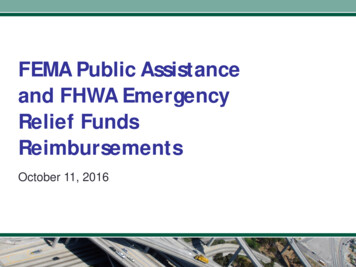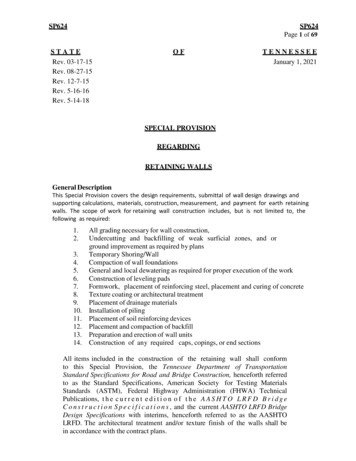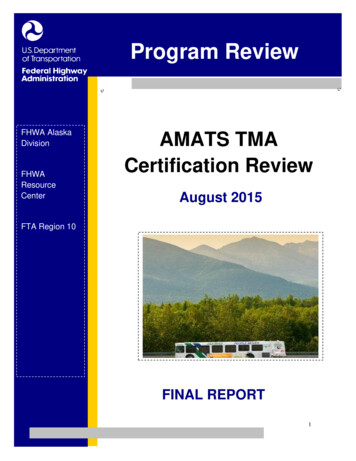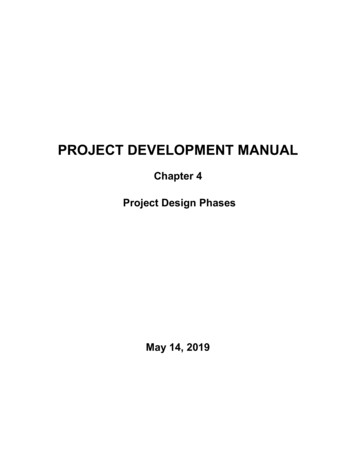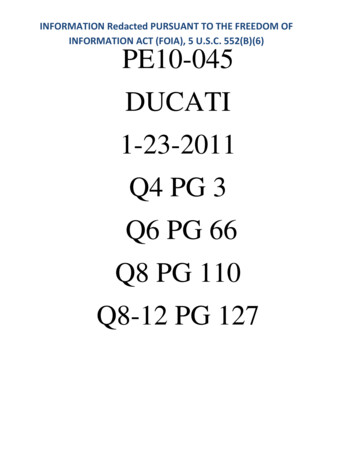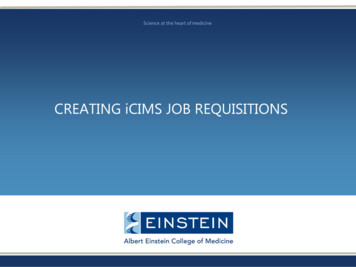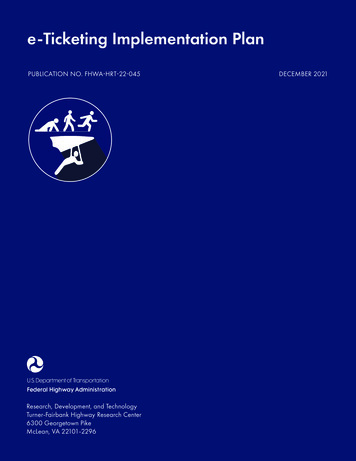
Transcription
e-Ticketing Implementation PlanPUBLICATION NO. FHWA-HRT-22-045Research, Development, and TechnologyTurner-Fairbank Highway Research Center6300 Georgetown PikeMcLean, VA 22101-2296DECEMBER 2021
EDC-6 e-Ticketing Implementation PlanFOREWORDHighway construction projects produce massive amounts of valuable data. Historically,information collected in highway construction projects was communicated via paper. Thepractice of solely using paper tickets, such as those collected from truck drivers to document theweight of every truckload of materials delivered at a job site, is cumbersome, inefficient, andoutdated.As transportation agencies are advancing faster toward paperless workflows for constructionadministration and management, electronic ticketing (e-Ticketing) automates the process ofcollecting paper tickets. e-Ticketing is a market-ready digital innovation that automates therecording and transfer of information in real time for materials as they are moved from the plantto the job site.This report is an implementation plan developed to assist the Federal Highway Administration(FHWA) with the planning of deployment activities for e-Ticketing under round six of the EveryDay Counts initiative. The Every Day Counts program works with State departments oftransportation, local agencies, and other stakeholders to identify and rapidly deploy proven andunderutilized innovations to shorten the project delivery process, enhance roadway safety, reducetraffic congestion, and integrate automation.Shay K. Burrows, P.E.Director, Office of Innovation ImplementationNoticeThis document is disseminated under the sponsorship of the U.S. Department of Transportation(USDOT) in the interest of information exchange. The U.S. Government assumes no liability forthe use of the information contained in this document.The U.S. Government does not endorse products or manufacturers. Trademarks ormanufacturers’ names appear in this report only because they are considered essential to theobjective of the document.Quality Assurance StatementThe Federal Highway Administration (FHWA) provides high-quality information to serveGovernment, industry, and the public in a manner that promotes public understanding. Standardsand policies are used to ensure and maximize the quality, objectivity, utility, and integrity of itsinformation. FHWA periodically reviews quality issues and adjusts its programs and processes toensure continuous quality improvement.Recommended citation: Federal Highway Administration, e-Ticketing Implementation Plan(Washington, DC: 2021) https://doi.org/10.21949/152173.Every Day Countsi
EDC-6 e-Ticketing Implementation PlanTECHNICAL REPORT DOCUMENTATION PAGE1. Report No.2. Government Accession No.FHWA-HRT-22-0454. Title and Subtitlee-Ticketing Implementation Plan3. Recipient’s Catalog No.5. Report DateDecember 20216. Performing Organization Code:7. Author(s)8. Performing Organization Report No.Suri Sadasivam, Roy Sturgill, Jagannath Mallela, and GabrielDadi9. Performing Organization Name and Address10. Work Unit No.WSP USA1015 Half St SE #650, Washington, DC 2000311. Contract or Grant No.693JJ319D000030/693JJ320F00047412. Sponsoring Agency Name and Address13. Type of Report and Period CoveredOffice of Infrastructure Research and DevelopmentEvery Day Counts Implementation Plan for 2021Federal Highway Administration20226300 Georgetown Pike14. Sponsoring Agency CodeMcLean, VA 22101-2296HRDI-2015. Supplementary NotesMatthew Corrigan (ORCID: 0000-0002-1230-8462) is the Task Order Contracting Officer’s Representative. Thisreport was developed under the FHWA Construction and Project Management Research and Technology Program.16. AbstractHistorically, on highway construction projects, truck drivers collect paper tickets for every truckload they haul to ajob site from a material plant. This practice of paper tickets is cumbersome and outdated. Electronic ticketing(e-Ticketing) automates the process. e-Ticketing is a market-ready digital innovation that automates the recordingand transfer of information in real time for materials as they are moved from the plant to the site.This report is the implementation plan developed to assist FHWA with the planning of e-Ticketing deploymentactivities under the sixth round of the Everyday Counts initiative (EDC-6).17. Key Words18. Distribution Statemente-Ticketing, material delivery, weigh tickets,No restrictions. This document is available to the publice-Construction, highway construction, information through the National Technical Information Service,management, innovation deployment, Every DaySpringfield, VA 22161.Countshttp://www.ntis.gov19. Security Classif. (of this report) 20. Security Classif. (of this page)21. No. of Pages22. PriceUnclassifiedUnclassified44N/AForm DOT F 1700.7 (8-72)Reproduction of completed page authorized.Every Day Countsii
EDC-6 e-Ticketing Implementation PlanSI* (MODERN METRIC) CONVERSION FACTORSAPPROXIMATE CONVERSIONS TO SI UNITSSymbolWhen You re inchessquare feetsquare yardacressquare milesfl ozgalft3yd3fluid ouncesgallonscubic feetcubic yardsozlbTouncespoundsshort tons (2,000 lb) poundforcepoundforce per square inchSymbolWhen You hakm2square millimeterssquare meterssquare metershectaressquare kilometersmLLm3m3millilitersliterscubic meterscubic metersgkgMg (or “t”)gramskilogramsmegagrams (or “metric ton”) CCelsiuslxcd/m2luxcandela/m2Multiply ByTo skilometersmmmmkm645.20.0930.8360.4052.59square millimeterssquare meterssquare metershectaressquare ters3.785liters0.028cubic meters0.765cubic metersNOTE: volumes greater than 1,000 L shall be shown in s (or “metric ton”)gkgMg (or “t”)Celsius pascalsNkPaTo 1.1952.470.386square inchessquare feetsquare yardsacressquare milesin2ft2yd2acmi20.0340.26435.3141.307fluid ouncesgallonscubic feetcubic yardsfl ozgalft3yd3ouncespoundsshort tons (2,000 lb)ozlbTFahrenheit Ffoot-candlesfoot-LambertsfcflTEMPERATURE (exact degrees)5 (F-32)/9or (F-32)/1.8ILLUMINATIONFORCE and PRESSURE or STRESSAPPROXIMATE CONVERSIONS FROM SI UNITSMultiply 1.103TEMPERATURE (exact degrees)1.8C 32ILLUMINATION0.09290.2919FORCE and PRESSURE or 5poundforce per square inchlbf/in2*SI is the symbol for International System of Units. Appropriate rounding should be made to comply with Section 4 of ASTM E380.(Revised March 2003)Every Day Countsiii
EDC-6 e-Ticketing Implementation PlanTABLE OF CONTENTSSECTION I: OVERVIEW AND INNOVATION DESCRIPTION . 1Background . 1Challenges . 1Benefits . 1Partners. 2State of Practice. 3Implementation Team and Key Stakeholders . 6SECTION II: MISSION STATEMENT. 7SECTION III: GOALS. 8Team Goals . 8National Goals . 8Innovation Goals (or Benefit Goals). 8SECTION IV: TARGET AUDIENCE. 9SECTION V: MARKET RESEARCH . 16General Market Research Approach . 16OBSTACLES, OPPORTUNITIES, STRATEGIES, TOOLS AND TACTICS. 20SECTION VI: PERFORMANCE MEASURES . 27SECTION VII: WORK PLAN . 28SECTION VIII: CONTINGENCY PLANNING . 32CONCLUSION . 33REFERENCES. 34Every Day Countsiv
EDC-6 e-Ticketing Implementation PlanLIST OF FIGURESFigure 1. Map. Current implementation of e-Ticketing by State transportation agencies(Dadi et al. 2020; National Asphalt Pavement Association 2020). . 3Figure 2. Maturity of e-Ticketing technologies. . 4LIST OF TABLESTable 1. Core implementation team. . 6Table 2. Target audience descriptors. . 10Table 3. Innovation market research. 17Table 4. Strengths, weaknesses, opportunities, and threats. . 20Table 5. Heat map. . 21Table 6. Marketing tools and tactics. . 26Table 7. Performance measurement. 27Table 8. Work plan. . 29Every Day Countsv
EDC-6 e-Ticketing Implementation PlanSECTION I: OVERVIEW AND INNOVATION DESCRIPTIONBACKGROUNDPaper-based load delivery tickets on highway construction projects have been used for manyyears. The use of paper tickets is a cumbersome, inefficient, and outdated practice. Thepossibility of using an electronic or digital process simplifies handling and integration ofmaterial data into construction management systems (CMS), or document management systems(DMS) for acceptance, payment, and source documentation.Electronic ticketing (e-Ticketing) is a market-ready innovation that digitally enables theexchange of information in real time as material deliveries are moved from the materials plant tothe construction site. Implementing this paperless process may occur in various configurationswhere technology solutions can create, share, track, document, and archive material information,such as material type, quantities, and delivery information, in electronic or digital format. This eticketing process typically pushes data to a cloud database for immediate access by multipleusers, via mobile devices or desktop/laptop computers, for material verification, information, andreal-time operational decisions. Although applicable to larger components, such as structuralmembers, e-Ticketing is especially suited to complement information exchange of bulk materialdelivery.CHALLENGESCollecting paper tickets from hauling vehicles exposes construction inspectors and contractorpersonnel to safety hazards in work zones. Paper-based ticketing is a linear andresource-intensive practice that entails multiple “touchpoints” for handoff and the recordation ofinformation through manual entry. The paper-based approach provides little traceability formaterials, and the data have fewer downstream uses. Lost or damaged tickets are also common.Both transportation agencies and the private sector spend considerable resources producing,sorting, recording, and archiving paper tickets. Furthermore, with State transportation agenciesfacing a chronic shortage of skilled inspectors, the paper-based practice requires an in-person“ticket taker” to collect tickets from drivers, record tonnage and location, calculate yield, andreport daily summary quantities.To meet Federal-aid Highway Program (FAHP) policies, State transportation agencies mustcollect, retain, and verify haul tickets for the projects that serve as source documentation. Thesource documentation serves as the basis of payment for materials incorporated into thecompleted work. Regardless of whether an electronic or digital process is used, e-Ticketing mustprovide reconstruction of the chain of events that occurs on the projects and must be acceptablefrom engineering, auditing, and legal standpoints (Federal Highway Administration (FHWA)1989).BENEFITSe-Ticketing mitigates the challenges of paper tickets through a safer, faster, lessresource-intensive, sustainable, and streamlined process that uses technology for information andEvery Day Counts1
EDC-6 e-Ticketing Implementation Plandata transfer. e-Ticketing data can be transmitted in real time to a cloud or storage system, thenbecome easily accessible by mobile devices, and thus, enabling operational decisions. Thiselectronic cloud approach creates a single source of truth that can be exchanged via applicationprogram interfaces (APIs) directly into department of transportation (DOT) informationmanagement systems, such as construction management or financial systems, for data mining,payment, or other purposes. e-Ticketing facilitates integration with complementary technologies,such as intelligent compaction, dielectric profiler systems, and pavement-mounted thermalprofilers. This integration offers a unique opportunity to access and analyze quality andproductivity data that are otherwise difficult to capture until after the completion of construction.With the implementation of e-Ticketing, transportation agencies can provide solutions toovercome pressing challenges and achieve the following benefits: Improved worker safety through reduced human-to-human interaction during tickethandoffs, because construction inspectors no longer must climb on delivery trucks toretrieve tickets while physically near moving traffic or construction equipment. Increased efficiencies with e-Ticketing over a paper-based process that includeautomating routine activities such as collecting and summarizing paper tickets, reducingthe workload of construction inspectors and allowing them to prioritize more criticalinspection elements; conserving resources associated with paper printing, storage, andarchiving records; and streamlining the payment process for fewer delays and lost tickets. Streamlined data management with e-Ticketing through electronic capture of data andopportunities for automated transmission and archiving. e-Ticketing also eliminates lostor damaged tickets; reduces handoffs involving paper tickets; eliminates manual ormultiple data entries; and automatically generates, transmits, and stores data in aconsistent, reliable, and usable format. Enhanced applications of digitalized e-Ticketing data, enriched with complementary datathat allows material placement to be traced, compliance assessed, and furtherinvestigations conducted for forensics, asset management, and other data-miningpurposes. Enriched data access through a single source that is available instantly to multiple usersvia web- or cloud-based interfaces and mobile devices in the field to enable automatedtracking of material delivery and real-time operational decisions.PARTNERSBoth agency and industry partners have contributed to this innovation through participation in atechnical working group (TWG). The TWG prepared and presented materials at the summits andworked together to develop this implementation plan. Section F identifies the members of theTWG.Every Day Counts2
EDC-6 e-Ticketing Implementation PlanSTATE OF PRACTICESince the first e-Ticketing pilot in 2015, the number of State transportation agencies adoptingthis technology has steadily increased (Dadi et al. 2020). Two surveys, both conducted in 2020as part of the Transportation Research Board’s National Cooperative Highway ResearchProgram Synthesis 545 Electronic Ticketing of Materials for Construction Management (Dadi etal. 2020) and the e-Ticketing Synopsis (National Asphalt Pavement Association 2020) found that29 agencies are using e-Ticketing on a pilot basis. Of these 29 agencies, 14 agencies piloted eTicketing before the 2020 construction season, while 15 agencies piloted e-Ticketing during the2020 construction season. Eight agencies are currently preparing for or considering a pilotproject. Figure 1 shows the implementation status of various States.Figure 2 maps the technology maturity of the e-Ticketing data to four maturity stages: crawl,walk, run, and fly. The “crawl” stage indicates a slow transition from the traditional usage ofpaper tickets to an image format for electronic transmittal, such as Portable Document Format(PDF), scanned, fax, or photo version of a paper ticket. Some State transportation agenciesaccepted image formats of paper tickets during the 2020 construction season.Source: FHWA.Figure 1. Map. Current implementation of e-Ticketing by State transportation agencies(Dadi et al. 2020; National Asphalt Pavement Association 2020).Every Day Counts3
EDC-6 e-Ticketing Implementation PlanSource: FHWA.Figure 2. Maturity of e-Ticketing technologies.Every Day Counts4
EDC-6 e-Ticketing Implementation PlanWhile image-based files are convenient for electronic transmittal and human readability, theoriginal paper ticket is still needed to serve as the source document and must eventually bedelivered to the project or retained by the contractor or supplier. Because the image files containunstructured data that are not machine readable, the information must still be manually extractedand entered into the agency’s business information systems.In the “walk” stage, the tickets are produced in an electronic format that is machine readablewith some structure to the data, such as comma-separated values, extensible markup language,and JavaScript Object Notation. The electronic tickets are transmitted in real time from load-outsystems to field inspectors directly or through a server. The State transportation agencies whohave implemented commercially available or in-house-developed e-Ticketing solutions haveachieved this maturity stage. The electronic ticket serves as a source document and must besecurely transmitted, stored, and archived in electronic form.The “run” stage indicates the maturity level where the electronic tickets are digitalized into semistructured data using a standard data schema for transmittal and exchange. The data fields areautomatically extracted, transformed, and loaded, via API, into an agency’s CMS, oralternatively, DMS or geographic information system (GIS), for further applications andarchived under the CMS’s protocol.The final “fly” stage envisions the use of object-based data. The ticket data are structured asdefined elements that are grouped intelligently, organized hierarchically, and linked with otherdatasets using GIS or building information modeling file formats, such as shapefiles, filegeodatabase, InfraGML encoding standard, or IFC alignment. The object-based ticket enforcesdata quality rules to validate data attribute and relationship requirements. The object-based ticketalso allows some operations, such as data retrieval or updating, to be automated using a set ofprocedures. The object-based ticket makes the data easier for use in extensive data miningapplications. In the object-based approach, payment can be automated based on the e-Ticket datatransfer.Every Day Counts5
EDC-6 e-Ticketing Implementation PlanIMPLEMENTATION TEAM AND KEY STAKEHOLDERSThe implementation team included technical experts from FHWA, State DOTs, academia, andindustry associations. Table 1 identifies the members of the core implementation team, theiraffiliation, and their roles.Table 1. Core implementation team.NameKathryn WeisnerAgencyFHWARole Assignmente-Ticketing team leadDennis DvorakFHWAe-Ticketing team co-leadMatthew CorriganFHWAResearchAntonio NievesFHWAHeadquarters constructionJeff WitheeFHWAQuality assuranceBrian LawrenceFHWAFHWA division officeRob ElliottFHWARick BradburyMaine DOTEDC-6 e-Ticketing and digitalas-builts coordinatorLead State championCedric WilkinsonIowa DOTLead State championMinnesota DOTLead State championJon MylerPennsylvania DOTLead State championKen TalbotUtah DOTLead State championAlexander HarrisAlabama DOTLead State championJacob BlanchardIndiana DOTLead State championWashington State DOTLead State championWest Virginia DOTLead State championIowa State Universitye-Ticketing championUniversity of Kentuckye-Ticketing championNational Asphalt PavementAssociationIowa Ready Mix ConcreteIndustry representativeNational Stone, Sand and GravelAssociationIndustry representativeRebecca EmbacherMarco FosterHao ChenRoy SturgillGabe DadiRichard WillisGreg MulderTom YieldingIndustry representativeEDC-6 Every Day Counts Round 6.Every Day Counts6
EDC-6 e-Ticketing Implementation PlanSECTION II: MISSION STATEMENTTo facilitate the adoption of e-Ticketing to increase safety, efficiency, and responsible use ofresources using cost-effective digital collaborative tools while saving lives, time, and taxpayerfunds.Every Day Counts7
EDC-6 e-Ticketing Implementation PlanSECTION III: GOALSThe e-Ticketing implementation team has identified several team, national, and innovation goalsto achieve through the EDC-6 initiative.TEAM GOALS Increase the number of State transportation agencies and local agencies institutionalizinge-Ticketing from 0 to 12 in 2 yr. Support all State transportation and local agencies in advancing their base-levelimplementation to the development, demonstration, assessment, or institutionalizationstage. Support the development of standard operating procedures, guidance on effectivepractices, sample or provisional specifications, and data standards for e-Ticketing. Increase the number of State transportation agencies expanding the application ofe-Ticketing to at least one additional use case (hot mix asphalt/warm mix asphaltready-mix, aggregate, salt, or other) beyond their baseline usage in tracking, recording,and verifying material information.NATIONAL GOALS Increase the number of State transportation agencies that have advanced the innovation,including proper independent verification techniques, in 2 yr. Increase the knowledge and acceptance of e-Ticketing among all target audiencemembers. Increase the number of State transportation agencies to expand the application ofe-Ticketing to at least one additional material type.INNOVATION GOALS (OR BENEFIT GOALS) Minimize worker exposure to reduce near-miss events, work-related injuries, andfatalities. Reduce time, resources, environmental impact, and financial expenseassociated with production, reproduction, distribution, exchange, and archiving ofpaper-based tickets. Streamline construction contract administration by integrating electronic and digitalworkflows through efficient data gathering and sharing. Improve timeliness and accuracy of payments through electronic submission of quantitydata and independent verification of the data for contract items paid by weight.Every Day Counts8
EDC-6 e-Ticketing Implementation PlanSECTION IV: TARGET AUDIENCEThe target audiences for implementing e-Ticketing are identified as primary and secondarystakeholder groups:Primary stakeholder groupThe primary stakeholders, who are the users and solution providers of the e-Ticketingtechnology, include: Transportation agencies (i.e., State transportation agencies, Federal Lands Highways,local public agencies). The State transportation agency stakeholders include executives;managers; engineers; inspectors of construction, materials, maintenance, and assetmanagement programs; and the offices handling information technology, contractadministration, financial management, audits, and economic opportunity (e.g.,compliance with disadvantaged business enterprises and the Davis-Bacon Act of 1971)(Public Law 71–798). Highway contractors (i.e., prime contractors and subcontractors). Operators of asphalt concrete and ready-mix concrete plants, manufacturers of otherconstruction and maintenance materials (e.g., aggregate, salt, millings) and products (e.g.,reinforcing steel, pipes), and materials suppliers. Third-party haulers. Technology solution providers (i.e., vendors).Secondary stakeholder groupThe secondary stakeholders, who are the users of the information created using the e-Ticketingtechnologies, include: Construction engineering and inspection (CEI) firms.Law enforcement (State and local).FHWA division offices.Federal Motor Carrier Safety Administration (FMCSA) or other State motor carrieragencies.Table 2 provides a summary of the target audience segments and associated characteristicsidentified by the team.Every Day Counts9
EDC-6 e-Ticketing Implementation PlanTable 2. Target audience descriptors.TargetAudience (TA)TA-1 administratorsOpportunitiesand NeedsObstacles andIssuesTargetedMessageImproved safetyImpedance withtechnologyadoptionSaves lives,money, timeProject ownersReduced rocessesData managersand usersFile formatsand datastandardizationMany vendorsolutionsWork zonesafetyValue dustryassociationsLack ofspecificationsSave money(papercreation andstorage)MaterialtraceabilityIncreasedproject costSave timeand effortAASHTOcommitteesTransparencyLack ofsupportingtechnologies(e.g., mobiledevices in thefield)Engageinspectionstaff forhigherpriority workInternalchampionData-miningValidation ofpermit/overweighttrucks/ haulroutesWorkforcedevelopmentTrainingIT concernsMobile deviceaccess to nonDOT systemsData ownershipand datasharingAccuracy ofquantitiesand paymentAttractyoung peopletotechnologyorientedworkEarly StateDOTadopters.StrategiesContract andpilotrequirementsWebinarPeerexchangesFHWA EDCeventsAASHTOcoordinationFact sheetMagazine andtrade articlesSTIC groupsFocus groupsUser producergroupsRegionalAASHTOconferencesPrivacy lawsDataverificationEvery Day Counts10
EDC-6 e-Ticketing Implementation ticsContractadministratorsOpportunitiesand NeedsObstacles andIssuesImproved safetyImpedance withtechnologyadoptionProject ownersReduced rocessesMany ndence onState agencysystems,processes,procedures, andspecificationsWorkforcedevelopmentIncreased projectcostLocal agencycertificationsLack ofsupportingtechnologiesData users andmanagersTransparencyFasterreimbursement byState/FederalagenciesFile formats anddatastandardizationLack ofspecificationsTrainingIT concernsMobile deviceaccess to nonState agencysystemsTargetedMessageSaves lives,money, timeWork zonesafetyValue addedworkSave money(papercreation andstorage)Save timeand effortEngageinspectionstaff forhigherpriorityworkAccuracy ofquantitiesandpaymentAttractyoungpeople tractorsContract hangesIndustryassociationsEarly nFHWA EDCeventsAASHTOcoordinationFact sheetMagazine andtrade articlesSTIC groupsFocus groupsUser producergroupsRegionalAASHTOconferencesData ownershipand data sharingPrivacy lawsData verificationEvery Day Counts11
EDC-6 e-Ticketing Implementation Data providersOpportunitiesand NeedsObstacles andIssuesTargetedMessageImproved safetyMany vendorsHigher ROIImproved profitsToo manyinfluencers(plant, placementcontractor, Stateagency andmaterial types)driving choicesCompetitionFewer disputesover paymentLess paperworkand fewer delaysLess storageneeds for paperNo lost ordamaged ticketsBilling efficiencyTransparencybetween partiesROI is yet to bedemonstrated ornot convincedSafety is not“apparent”Data securityLimitations ondata sharing bythird partiesPosition insupply chain andshare of businessfrom governmentworkQuickerpayment forworkEfficiencyof work, notlosing timeand moneyin trackingdown paperticketsWay tomeasureefficiency ofsub to binarSuppliersPeer exchangesVendersFHWA EDC eventsFHWAAGC, NAPA andassociation meetingsAGC, NAPA,and otherprofessionalassociationsTrade articlesUser producer groupsWorkforcedevelopmentConnectivity inremote and highelevation areas,whilealternatives areexpensiveLack of
Electronic ticketing (e-Ticketing) automates the process. e-Ticketing is a market-ready digital innovation that automates the recording and transfer of information in real time for materials as they are moved from the plant to the site. This report is the implementation plan developed to assist FHWA with the planning of e-Ticketing deployment


